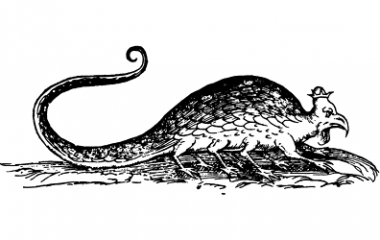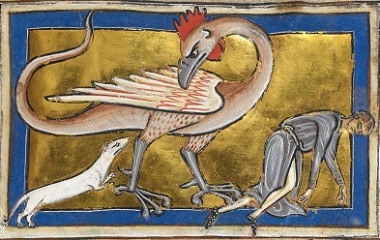What is a Basilisk?
A Basilisk (or cockatrice) is a chimeric monster, born from a toad or serpent’s egg incubated under a cockerel. The terrible offspring that hatches from this egg is half-bird, half-snake, and all evil. It is one of the deadliest creatures to menace the mythological world, and it is extremely hostile towards mankind.
Characteristics
Physical Description
The Basilisk’s horrific body is patched together from pieces of a dragon, a serpent, and a cockerel. It has a cockerel’s flashy, feathered head and is supported by two spindly chicken legs. Dragon wings erupt from its shoulders, and a long serpentine tail completes its shudder-worthy look. Although this chimera is a deadly enemy, it can be very small. Early accounts of the monster describe it as a mere 6-12 inches long.
Alternatively, the Basilisk is sometimes described as a giant snake, without the cockerel’s head or wings. Still, its movement is unlike other snakes. Rather than slithering with its stomach on the ground, it crawls forward with the front half of its body towering above the earth. Snake-like Basilisks usually reach gigantic proportions.
Special Abilities
The Basilisk is, with good reason, one of the most feared beasts in all folklore. It can kill or seriously injure a man in five different ways, and most of them don’t even involve the awful creature risking its own skin in the fight.
The monster’s most famous weapon is its dreaded gaze. The potency of its gaze is discussed in all the myths that relate to him, across several different cultures. No matter when, where, or who you are, if you meet the eyes of a Basilisk, you’re done for.
Second to the monster’s gaze is its putrid breath, so terrible that it can wither plants and incapacitate grown men. Some scholars even report that the monster can spout fire.
The monster’s venom is a third and terrible weapon. It is so toxic that it can kill a man from a meter’s distance. In one story, the venom travelled up a warrior’s spear, after he stabbed a Basilisk, and was so strong that it killed both the warrior and his horse upon contact.
As a fourth weapon, the monster can use its sinister half-bird-half-reptilian hiss to madden, paralyze, or kill men. Finally, touching one of these dark creatures, even if you aren’t exposed to its gaze, breath, venom, or hiss, might result in your death.
Of course, the Basilisk is a menace to more than just men. This monster leaves a path of destruction wherever he goes. Plants are scorched by its stench and evil spirit, birds burst into flame if they get too close to him, and other snakes flee from him, knowing that he has a bit of a cannibalistic appetite.
Weaknesses
Your best chance of surviving an encounter with a Basilisk is avoiding an encounter with a Basilisk—but even these deadly monsters have some chinks in their armor.
Weasels and cocks are worthier opponents for the terrible chimeras than men. Weasels are immune to their fatal glance, and they can even survive a venomous bite if they receive proper medical treatment. Many old texts urge would-be Basilisk killers to throw a weasel into the beast’s den, or vice versa, and let them fight it out. The sound of a cock’s crow can reduce the monster to ashes.
If you do find yourself in the presence of one of these dread chimeras, there is just one weapon that can save you: a mirror. Just as its gaze is lethal to all other living creatures, so too will the monster perish if it is forced to look into the eyes of its reflection.
Related Creatures
The terms “Cockatrice” and “Basilisk” are often used interchangeably, and if the two creatures aren’t synonymous, they are at least extremely similar. Some texts state that the cockatrice is hatched from a cock’s egg incubated by a toad or serpent, the reverse of the process by which Basilisk’s are born, and cockatrices are never depicted in the giant-snake form that has become popular for the Basilisk in contemporary fantasy.
Cultural Representation
Literature
Pliny the Elder gave history its first glimpse of the fearsome Basilisk in his groundbreaking text Natural History, which was published in 79 CE. He wrote,
“It routs all snakes with its hiss, and does not move its body forward in manifold coils like the other snakes but advancing with its middle raised high. It kills bushes not only by its touch but also by its breath, scorches up grass and bursts rocks. Its effect on other animals is disastrous.”
Scholars of the natural world continued to expand upon the “basilisk’s” story over time. Bede described the birth of the basilisk, and Alexander Neckham and Albertus Magnus wrote about its foul stench and deadly gaze. Leonardo da Vinci described a white, diadem-like marking on its head in his Bestiary.
In the fourteenth century, the Greek word, basilisk, was translated into the French word, cockatrice. This new name was popularized when it began appearing in Bibles to describe serpentine monsters who had spirits of pure evil.
Gradually, the Basilisk moved out of the realm of scientific study and into the realm of folklore, where it appeared in Geoffrey Chaucer’s Canterbury Tales. Finally, the great monster became the stuff of poetry, where its name alone was used by Shakespeare, Voltaire, and Bram Stoker to express deadly loathing.
Visual Arts
The Basilisk is a common ornament in large works of art, especially from the fourteenth to sixteenth century. Although the small monster is rarely an artistic centerpiece, he can often be found among the demons in the architectural molding of grand cathedrals or peeking out from the background of family crests.
Alchemy
The Basilisk’s magnificent power may stay with him after its death. When the monster is reduced to ashes, its ashes retain magical properties that were highly sought after by alchemists in the thirteenth century. One legend describes an alchemist using the monster’s ashes to turn silver into gold, while other legends hint that the ashes are an important ingredient in the making of the Philosopher’s Stone.
Explanation of the Myth
Luckily for mankind, no monster as deadly as the Basilisk has ever roamed the earth—but the legend of this monster probably was inspired by one of the world’s most dangerous predators: the cobra.
Pliny the Elder, an early naturalist who was the first to make a written record of the “little royal” Basilisk, connected the monster with Egypt by observing that it liked to live in dry, sandy places and sometimes laid in wait to attack Nile crocodiles. Likewise, the cobra lives in Egypt, where it is revered as a symbol of magic and royalty.
Early physical descriptions of the “basilisk” also match up with a cobra. Like the basilisk, the cobra can slither across the ground with the front half of its body raised in the air. The large hood around its head, which bears an ornate white marking, gives it a strange, un-snakelike appearance. It is famous for its entrancing stare and its ability to spit highly toxic venom for long distances, as well as its appetite for eating other snakes. Birds of prey and mongooses, a relative of the weasel, are the only known predators of the cobra.










